
Socorro (Revillagigedos): January 2016
Monday, January 25, 2016: Getting there
Manta madness is a disease to which I happily succumbed recently. Although there were sharks, schooling fishes and other diversions in Socorro, also known as the Mexican Galapagos, when a manta was around, I only had eyes for Manta birostris.
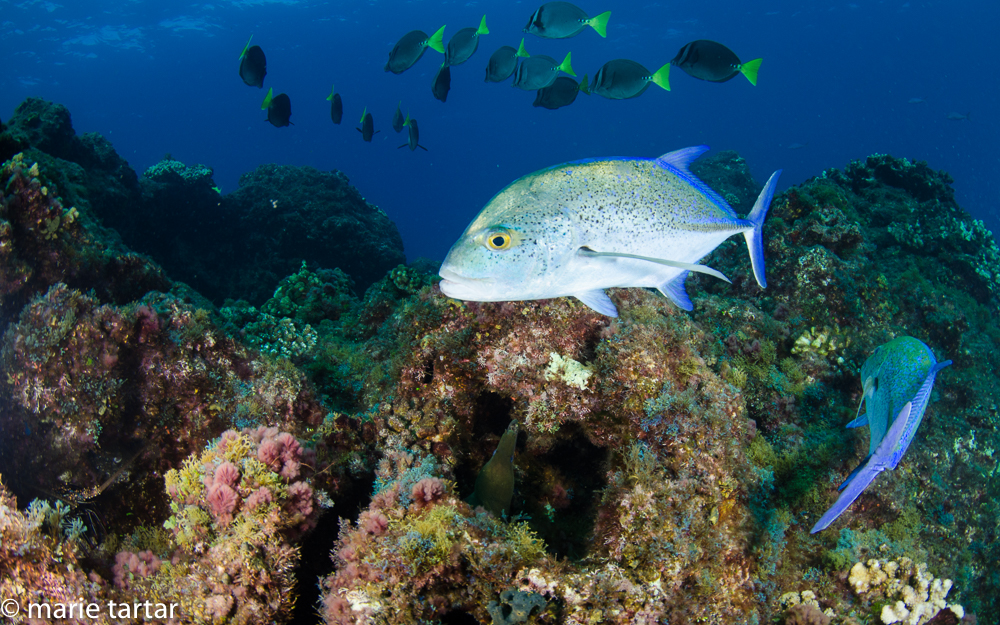
Other residents of Isla San Benedicto: lobster at left, eel center, blue-spotted jack (Caranx melampygus) foreground, surgeonfish in water column background
Although we have logged many hours with mantas before, most of those occasions were much more controlled, kneeling on sand at cleaning stations in Papua New Guinea and Indonesia. Swimming eye-to-eye with an oceanic manta ray, a large ray that can flee in two beats of their graceful wings or choose to stay and interact, is an otherworldly and entirely addictive experience.
Symptoms of this sickness included bouncing from one depth to another, near in-water collisions with other divers also closing in on a manta with laser-like focus and finding oneself in blue water with no island visible for reference. Other symptoms are less dangerous, namely giddy smiles, exultation and a profound sense of communing with an intelligent creature from another planet.
Surprisingly, it was with some ambivalence that we ultimately decided to come on this trip. It had been a long time since our only prior trip to this remote destination.
Ambivalence about a dive trip? This was a first for us. There were many contributing factors. We signed up shortly after an April, 2014 Indonesian dive trip on Pindito, led by Fred Dion, so a lot of time had elapsed. We were coming off another Indonesian voyage on Pindito in November, 2015, during which we had incredible manta encounters. Could we possibly top the eye to eye interactions we had at Magic Mountain so recently?
Then there was the seasickness factor. The Revillagigedos Archipelago (the official name, difficult enough to pronounce that most people refer to the islands as Socorro; to add to the confusion, one of the 4 islands making up the archipelago is Socorro Island) is a notoriously nauseating 24 hour boat trip from Cabo san Lucas at the southern tip of the Baja peninsula.
Our one and only prior trip there was on a much smaller private boat, the Ambar III, in 2004 and the 24 hour trip out there was utter misery for me, the only time I have ever been too sick to eat. Those who know me know I like to eat, and eating being good for keeping seasickness at bay, know I must have been REALLY indisposed to not be ABLE to eat.
Concerns about the operation were raised by a less than entirely favorable review in Undercurrent, the on line dive operator review publication. Dinner with our diving friends Lauren and Brad brought this to light.
Then there was the other possibilities factor. Our friends Cindy and Gerry have an interest in a fractional apartment in Paris where we have happily spent a number of weeks in recent years. In the fall, a few weeks before our final payment for the dive trip was due, we learned time was available in the apartment during the same time frame.
In the fall of 2015, another factor was playing on our minds. We were feeling financially overtaxed (not a sympathy ploy, just our state of mind), and the dive trip was relatively expensive for the length of the trip (7 days total, 2 spent in transit to and from the islands, 5 actual dive days). I hadn’t booked the airplane tickets yet, and the apartment in Paris was next to free. Could we save money going to Paris for 2 weeks instead of diving Socorro? Was this a sign of aging, to even be doing this mental calculus? It all came down to how much money we would lose backing out of the trip at a comparatively late date.
We didn’t like the answer, which was about $2000, too much to forfeit. We had originally signed up for the premium suite, so downgrading to a superior suite (doing without a living room and TV, no great sacrifice) would save us $1000, which lowered the remaining tariff. So, as late as November, we settled our mental debate, paid the final installment and resolved to go to Socorro.
Getting there was easy…for us. A non-stop 2 hour flight and one of those cheap, last minute upgrades for which I love Alaska Airlines, and we were there. It was not so easy for some of our travel companions, who were waylaid by snow Stormageddon blanketing the East coast. I thought Joanna, coming from Toronto, might have a problem, but apparently the storm didn’t extend that far north. Jake and Ethan, coming from the Boston area, also were fine. But Joanna’s roommate to be was caught in the maelstrom of storm-related flight cancellations and bailed on the trip. Louie was on tenderhooks until the last minute, making contingency plans to leave from an alternate airport, and just made it out after spending the day prior to departure on the phone. His dive gear did not make it with him, but he hand carried his camera with him, and with borrowed gear contributed by the boat and other guests, he was good to go.
This was definitely a virtual reunion of our Mr. Fred Pindito dive group, minus Mr. Fred, who had since abandoned civilization to become the photo pro at macro mecca Maluku Divers in Ambon, Indonesia. Now leading the group was Fred’s friend, Marty Snyderman, also our friend and neighbor from San Diego. Back together again were wine connaisseur and fellow Francophile Jake, Louie from Virginia, commercial diver Donnie, Joanna, Erin and Tim from Wisconsin, Iowan Kevin, Mark from Pennsylvania and Joel from Florida. New to us were Donnie’s friend and professional camerawoman Tammy, Joel’s wife Carrie (on her first live-aboard), Jake’s friend Ethan (former editor of Fathoms Magazine turned website designer), turkey hunter and drone pilot Francisco from Mexico City, Cozumel dive guide Jeremy, Russian engineer and entrepreneur Mikhail and his wife Natasha, Mark’s friend psychiatrist Steve and Steve’s high school age son Danny, and recently retired radiologist Steve. Trying to keep us corralled underwater were dive guides Dave and Arturo. Chef Luis kept everyone happily fed, aided by Laurentina and Nubia. Waiting in pangas overhead at the end of our dives was Hernan, sporting a straw hat topped with a plastic pinniped, and Jordan. Captain Sandy was in charge. Juan helped wrestle the pangas into submission for boarding.
Tuesday, January 26, 2016 was devoting to the long drive out there, with only seabirds for companions.
Wednesday, January 27, 2016
Isla San Benedicto
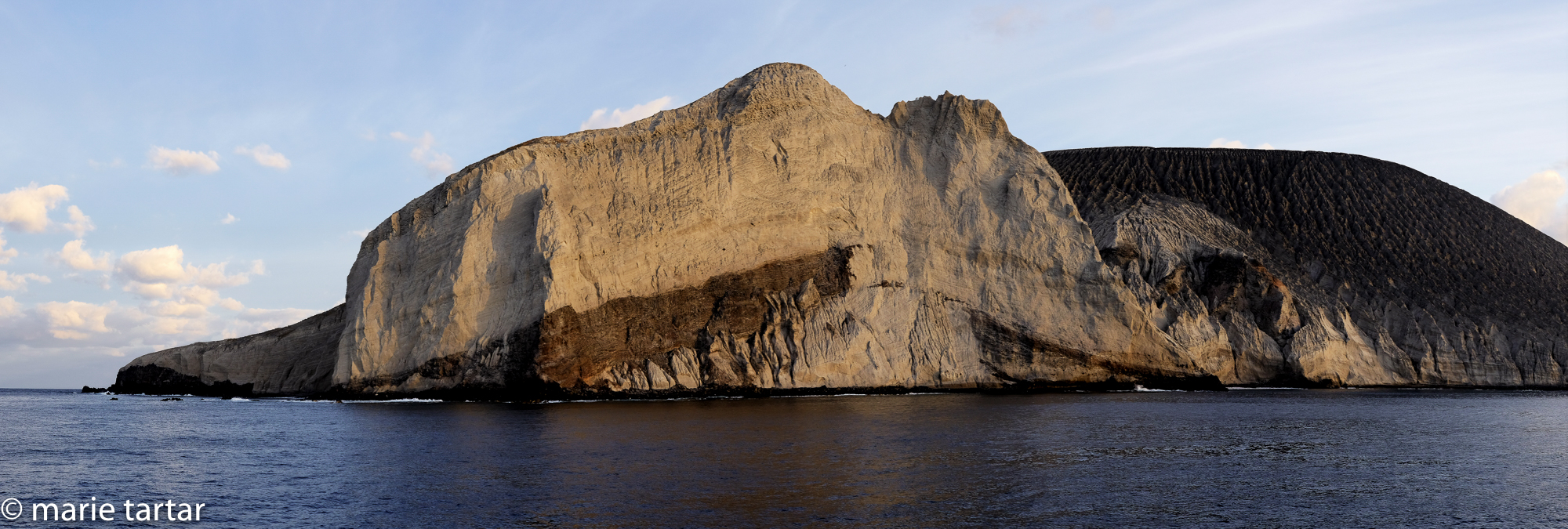
Socorro consists of 4 barren volcanic islands with their own ecosystem, including sculptural Isla San Bendicto
Dive # 1, El Canyon, reportedly was a horseshoe shaped array of rocks, but I never was able to assess it myself. My maiden voyage in a brand new Henderson AquaLock 7 mm suit was fraught with a string of errors. Judging from being able to dive with 8 pounds of weight in a 5 mm version of the same suit (admittedly, compressed by many dives), I thought a starting guestimate of 14 pounds weight might work. Another problem, discovered while suiting up, was that my new matching booties did not fit into the foot pocket of my fins, a possibility that should have occurred to me before packing, but didn’t. The crew produced another set of boat booties, which were too big. Juan the deckhand offered his fins, which did fit over the bulky booties. I broke a finstrap while trying them on, which was quickly replaced. Once in the water, I bobbed like a buoy. Hernan, the panga driver, added a 2 # weight to my pocket, with no effect. Still not able to descend, I made my way back to the skiff. Carrie was also there, seeking more weight to offset her new 7 mm suit. Only a 5 # weight remained in the panga.
Hernan hesitated: “That’s a big change.”
I suggested he take back the 2 # he had just given me and give it to Carrie, and I would take the 5 #. By the time this exchange was made, we had drifted from the site, so Hernan had us hang off the bow while he towed the 3 of us back to the starting point. At first, I didn’t have my regulator in my mouth, a big, miserable mistake! The tow was not at all pleasant, being dragged through the water, trying not to bash each other under the bow. One hand was occupied by the camera, and the other clung claw-like to the rigging. Once at the site, Carrie and Joel descended and I tried again, now with 19 #, again to no avail.
While trying, I suddenly had much less control over my body position in the water and saw, to my dismay, one of the borrowed fins was descending without me. There was no more weight in the boat for me to put on to try to retrieve it. I felt terrible, but Juan was really nice about it. I offered to pay him for new ones, but he keep repeating: “Está bien, está bien.”
Dives # 2 and #3 to La Cuevita (Little Caves) went much better, mucho mejor que el primero buceo! We dove from the Nautilus Explorer, taking the pressure off in re-assessing my weight just off the stern of the big boat, without the camera. 22 # resulted in a nice gradual descent in this extremely buoyant new suit.
The site is a jumble of large boulders, some piled up to form swimthroughs, which shelter schools of fish. In an alcove, I found Steve, shooting a pile of white tip sharks resting on the floor.
A large ray rested on the sand. Another section of a mini-wall held multiple large colorful lobsters.
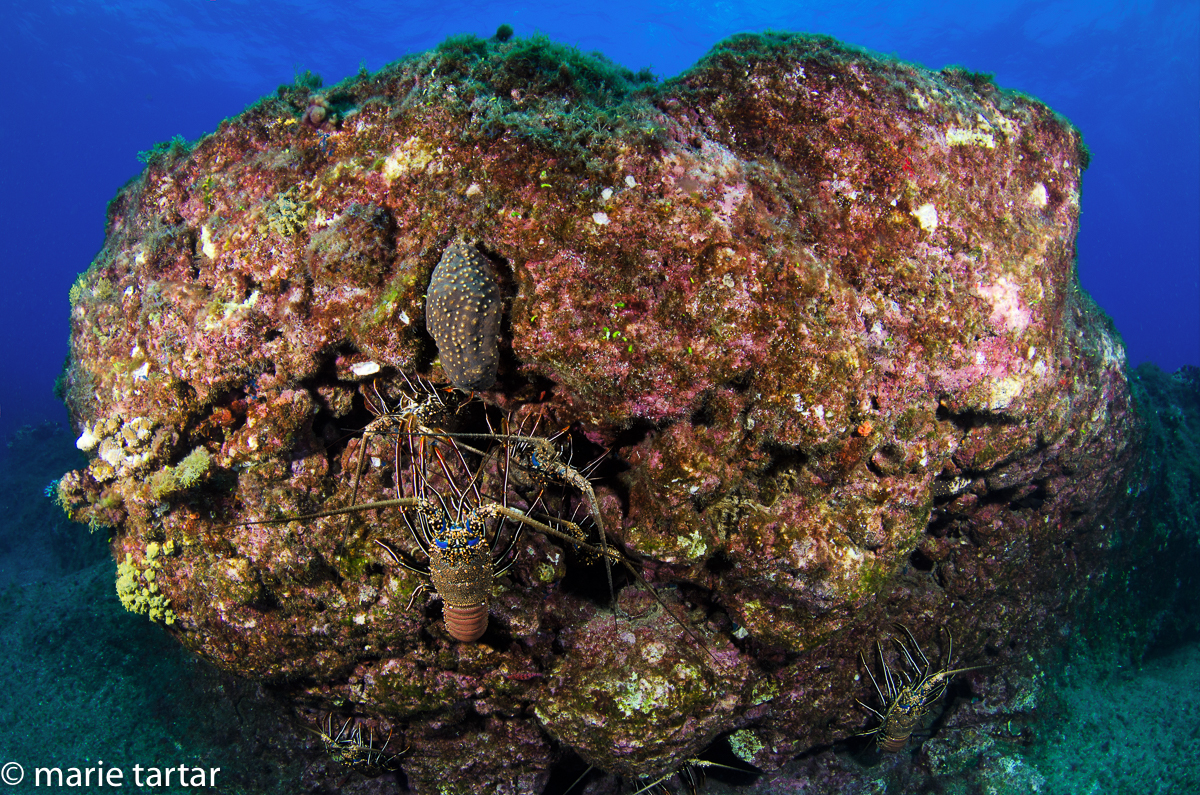
Rock lobster! That is, lot of lobster studding this rock at Isla San Benedicto, Revillagigedos, Mexico.
Our late afternoon dive, # 4, at The Boiler, was not boiling. Although this is a site where mantas are reliably seen, none materialized.
Thursday, January 28, 2016: Roca Partida

Roca Partida and dive boat (sister ship Belle Amie). Roca Partida is a lonely place, completely exposed to the elements, with no place to shelter from inclement weather; we were lucky to be able to spend 2 days there
Roca Partida is a “split rock”, capped with white guano. The surface was choppy and the sky steely grey overcast. Launching the divers, cameras and fins into the pangas is a bit commando, with the skiff driver partially launching the boat onto the sloped stern of the Nautilus. This arrangement works fine when it is flat, as we later saw. When it is pitching, the panga warps and nearly doubles over, squishing the divers on board into each other, who flail trying to stabilize themselves and any cameras which have made it on board. The noise as the skiff deforms, akin to the rumbling of a terrifying beast, added to the anxiety.
Underwater, the first dive for me can be summarized as beauty and disaster, with wonderfully close manta circles, but my camera battery suddenly was dead, despite being freshly charged! It was a most untimely battery death, to say the least. What a time for a battery to go bad!
Back on board, there was a call for a doctor, just as hard of hearing Steve whisked up the ladder to our room. On this voyage, that is one profession not in short supply. Besides Steve and me, there are 2 additional Dr. Steves, one a recently retired radiologist and the other a psychiatrist. Cardiologist Mark brought to 5 the number of MDs on board, with podiatrist Kevin, occupational therapist Louie, chemotherapy infusion nurse Carrie and exotic bird veterinarian Joel rounding out the considerable medical expertise on board, not to mention radiopharmaceutical expert Joanna. Tammy was white-lipped as she was rushed from the panga to the salon. Donnie said she complained of not being able to breath as soon after she surfaced, although she completed her safety stop. It sounded like she overtaxed her regulator, and was still drawing heavily on it even during her safety stop. She never lost consciousness and was able to talk and even joke. I thought she probably over-exerted, hyperventilated and had a borderline panic episode. She recovered quickly, with no apparent after effects, sitting out a subsequent dive.
Dive # 2, after swapping out the camera battery, was to the backside of Roca Partida, which had abundant patrolling white tip sharks, and multiple adjacent ledges occupied by piled up white tips.
The surge was active enough that approaching close enough to the rock was tricky, but doable. Then, the mantas came in, first one, then another, finally three.
During dive # 3, the mantas came in early, but didn’t stay. Jeremy and a group followed a small one into the blue and had a nice encounter. Steve and I stayed at Roca Partida, shooting the white tip shark pile-ups on the shelves.

Mexican hogfish (Bodianus diplotaenia, upper right) photobombs an aggregation of white tip sharks on a ledge at Roca Partida
Steve shot the surge itself as we ascended.
Back on the boat, we both skipped the last dive, being cold, tired and beat. I had a headache, which responded to a nap.
After dinner, our lights attracted silky sharks in, circling the stern.
Friday, January 29, 2016
Day #2 at Roca Partida
On dive # 1, we saw mantas, but deep. The depth started out reasonable, 60 feet or so, but spiraled down, 70 feet, then 80, then 90. I quit at 96 feet, and retreated upwards, to 60 feet, trying to will them to follow.
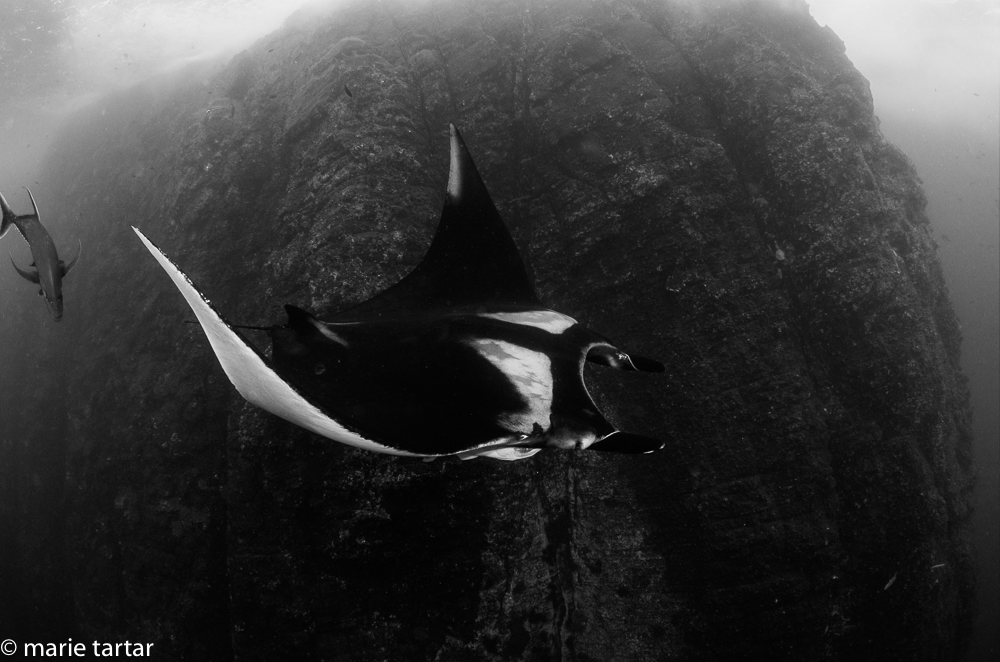
Roca Partida is an imposing rock, above and below the surface. It is completely exposed, so can only be dove when conditions cooperate
Dive # 3: Best safety stop ever! Just as I was resigning myself to a ho hum dive, and making my way up slowly for my safety stop, everything changed. Steve had been along the wall, shooting the turbulence at the surface. The surge made this a risky proposition, whisking him at one point from 60 feet to 12 feet. I had already stopped in to check on the dens of white tip sharks and found the surge varying from pleasant, whisking me from side to side like a washing machine, to borderline unmanageable.

A gaggle of white tip sharks in a pile-up on a ledge at Roca Partida appear to hungrily eye a cache of lobsters living next door
Divemaster Dave was ahead and below us. A manta came up the wall and began circling the small group of remaining divers, including me, Francisco, Louie and Dave. Louie had already signaled he thought the dive over, turning off his strobes and folding in his strobe arms, when it really heated up.
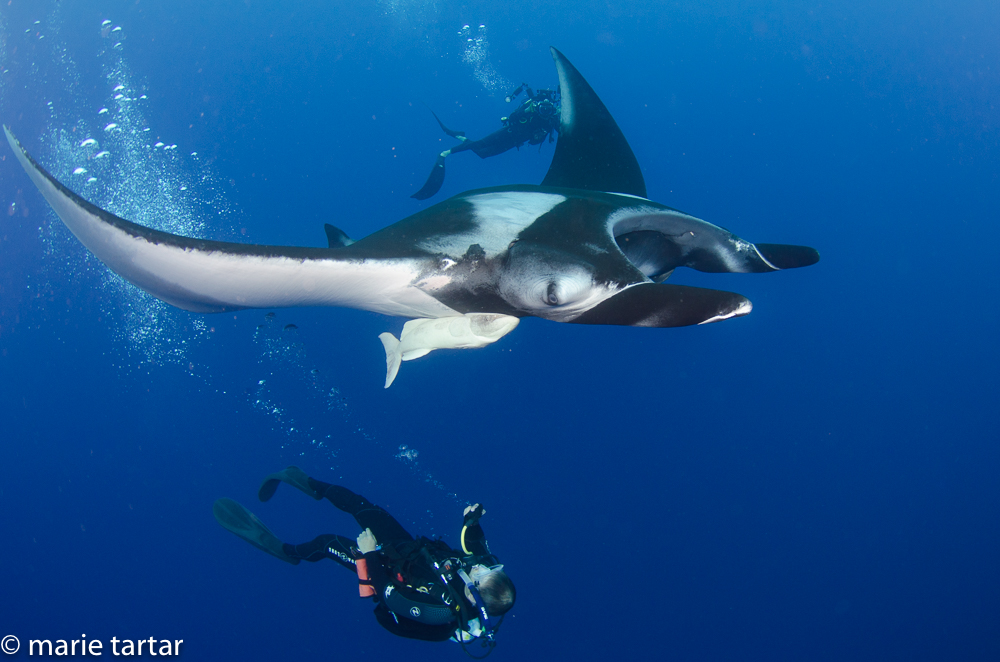
An unusual trait of Socorro’s population of oceanic manta rays is that they actually seem to enjoy SCUBA bubbles. Divemaster Dave frequently swam underneath a manta, exhausting his second stage regulator. Here, Louie is trying this technique, having handed off his camera to Dave, in the background
Saturday, January 30, 2016
Socorro (Cabo Pearce)
After an easy crossing, the first night I really slept well, we awoke to sun at Socorro, where the Mexican Navy has a base. The Nautilus Explorer’s sister ship, the Belle Amie, was also there. A small settlement has an uneasy perch on the volcanic island.

Nautilus Explorer’s sister ship, Belle Amie, at Socorro Island, where there is a small Mexican Navy post
Our dive day started later, with checking in with the Navy the first order of business. In the mean time, we watched a TED talk on mantas by Robert Rubin, PhD, followed by a short talk by divemaster Dave.
In the water, we followed Arturo to the buoy placed by Belle Amie. Two mantas were already circling and they intermittently appeared throughout the dive. The Belle Amie divers were still down when we arrived, but gradually, the field cleared of bubbles, leaving Louie and me again in the shallows with two mantas circling, one doing a barrel roll right in front of me!
Dive # 2 was after a lunch of lentil soup, lasagna and salad. As we arrived at the site, the report from the group that just entered was that the current was strong. We again followed Arturo along the wall. Mantas materialized as soon as we arrived at the site. The topography is sculptural beige rock, studded with black spiny sea urchins and barnacles, not an easy place on which to hunker down.
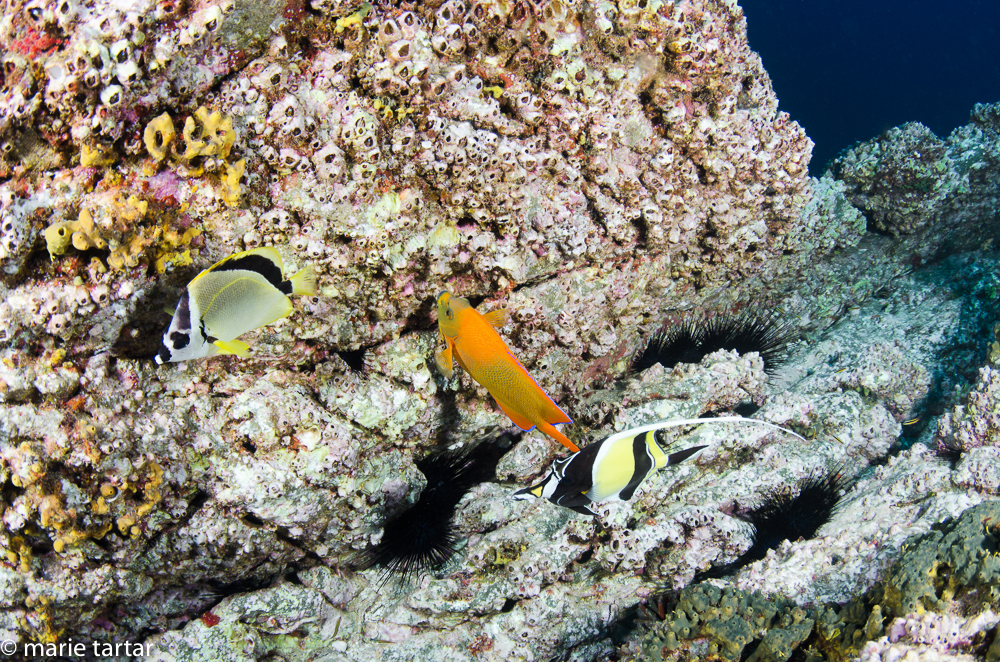
Some of the fish found at Isla Socorro: barberfish (Johnrandallia nigrirostris), Clarion angelfish (Holacanthus clarionensis) and Moorish idol (Zanclus cornutus) at Isla Socorro
Up in the water column, the current was easier to deal with. Keeping one eye on the buoy and attached line and rocky ledge, and the other out to the blue, we spun around and around as mantas swooped in from the edge of perception. Chasing after them is futile, better to anticipate the manta’s trajectory and position oneself at a likely intersection.
After a while, a small group of us, me, Steve, Louie and Francisco, succumbed to manta madness, following first one, then another, then both, further away from the buoy and any landmarks. As long as I could see another diver, I thought we were OK to carry on. Trying to maintain a constant depth was challenging, now 45 feet, now 20 feet. Watching Steve pursue a manta deeper and deeper toward the end of the dive, knowing he must be low on air, I could only hope he had a handle on his remaining air supply. Surfacing after our mantas left us, we found ourselves a good distance away from the wall, but the skiff readily spotted our exuberant group.
Evidently, our drifting off the site, even as a group, was a breach of protocol, as Arturo assembled us in the salon for a refresher briefing before the late afternoon dive, reiterating the 3 rules of Socorros manta diving:
Don’t chase the mantas
Don’t lose sight of the dive site
Don’t follow the mantas into the blue
On dive # 3, the mantas showed up promptly, but the visibility made it challenging to track them. We spotted cooperatively, pointed out approaching mantas to divers with their backs turned.
Afterwards, we tested the hot tub’s capacity, filling it to near overflowing with Steven, Danny, Mark, me, Erin, Tim, Joanna, Louie, Tammy and Kevin.
Later, Jordan organized a conservation fund raiser, Chase the Ace. Mikhail was the winner, but seemed bewildered by the proceedings and promptly donated his take back into the pot.
After a dinner of mashed potatoes, cauliflower, carrots and roast beef, the pool was opened for a night snorkel. The nights before at Roca Partida, silkies had been abundantly evident at the stern, attracted by the boat’s lights. This evening, Jeremy was the first in, although silkies were not abundant. Although he had been diving in a drysuit all week, he was adorned only in an elaborate tattoo and his Shrek cap for the night plunge. One by one, Kevin, Francisco, Joanna, Mikhail, Danny and Joel joined him. The best part about the night snorkel was the hot chocolate souped up with Bailey’s which appeared on the back deck.
Saturday, January 31, 2016
For our last dive day, it was back to the Boiler of Isla San Benedicto.
One of the pangas misbehaving meant Hernan had to double back for us, the second half of the Red Group, making us last into the water. The visibility was poor, very milky. It was easier to judge the approximate location of a manta by flashes going off and /or Mikhail’s light up the night headlights zooming around.
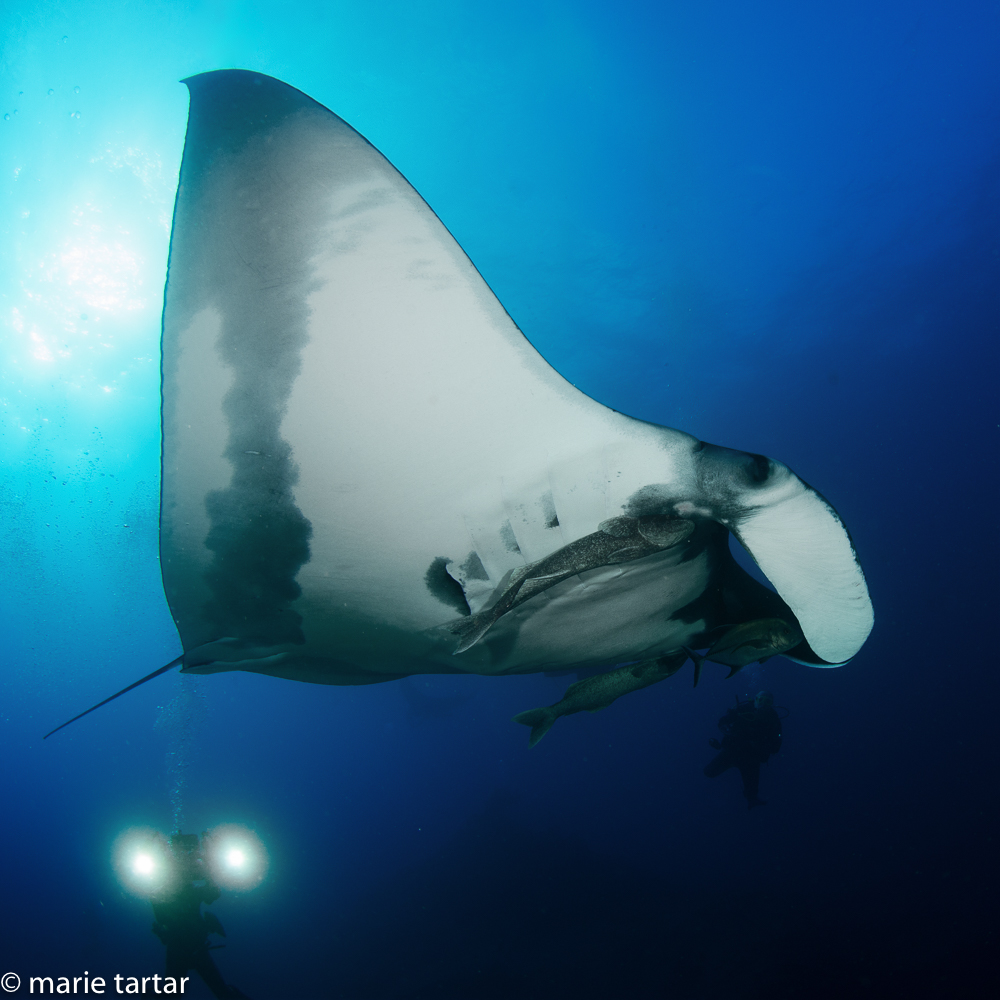
Manta and men, including Mikhail, armed with a painfully powerful set of video lights, and Steve K (right)
Down in the depths, I heard pinging of dolphins moments before actually seeing a group, deep, down below me. I could see Steve was in a better position to shoot them, so made no attempt to descend further.
Back with the mantas, it was chaos, with too many bubbles and divers, too little visibility and too few mantas.
I found myself away from the rapidly receding rock with fewer and fewer divers, eventually just me and Steve. We had one good close manta inspection before finding ourselves without any point of reference. When we surfaced, we found we were nearly to the boat, as was another group. The current pushed us toward the boat, toward which we swam, arriving without a panga pickup.
The after lunch dive started with divemaster Dave gesturing me to swim toward the rock, as he swam after Steve and Danny to make sure they were heading the right way. The rock was an amorphous shadow in the distance. Once there, I saw Steve and Danny briefly, appearing to have an animated underwater conversation. I found myself on the corner, with only Louie, in a dense murky mist. For quite a while, we saw no other divers, bubbles, or mantas. We had to keep a little distance from the Boiler, lest the surge bash us against the rock. At the same time, we had to stay in visual contact with the rock, there being no other point of reference. I felt like two small children lost in a forest shrouded with fog.
I strained my eyes in every direction. At one point, I thought I saw bubbles. As I swam in that direction, I wasn’t sure what I had seen wasn’t a trick of the light. But it did prove to be a small group of divers, including Donnie, Joanna, Tammy, Erin and Tim, being circled occasionally by a manta. But the shooting wasn’t good, as the mantas seemed to loom up so suddenly it was difficult to be prepared.
I was on the fence about even doing the final fourth dive at The Boiler, but figured it couldn’t be worse than #3 and might be considerably better. This proved to be the case, so I ended up being really glad I went, ending the trip on a manta high note. The visibility was still terribly opaque, but despite it, the 2 mantas which circled us almost continuously seemed easier to spot. Marty had mentioned just before going in the water that he had been shooting mostly silhouettes, which seemed like a good idea given the particulate load in the water. I also tried shooting from below the animals, including and blocking the sunball. I also dropped another couple of pounds weight, which required a little effort to initially descend but seemed overall about right (I started at 22# earlier in the trip, and ended with 14# with the no longer new, but still very warm and buoyant, 7 mm full wetsuit with gloves, 3 mm hood and thin booties.)
Sunday, February 1, 2016 was a miserable day, entirely in transit back, rolling all day long in seas up to 12 feet. Most people, including me, were sea-sick, others medicated and compensated to variable degrees. I thought often and longingly of the Scopolamine patches forgotten at home, sitting safely in the bathroom, doing me absolutely no good on the shelf.
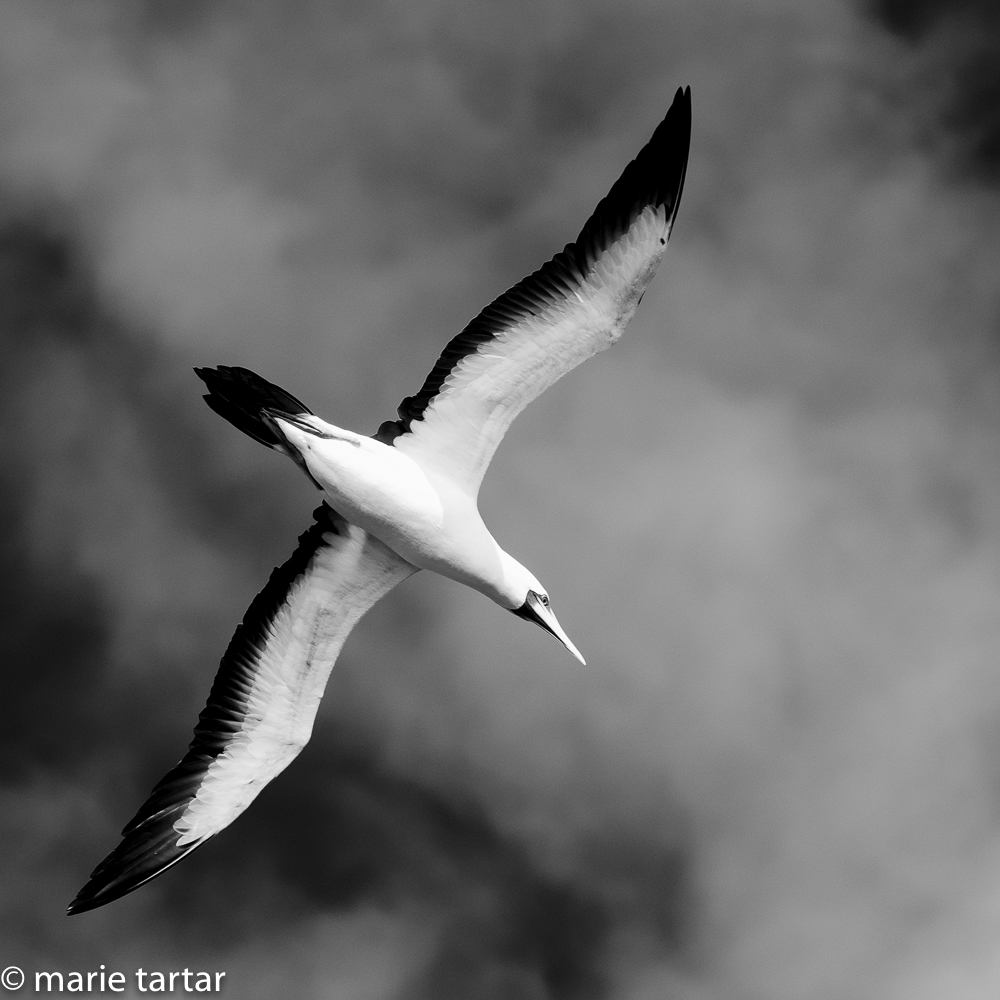
For a few minutes, I felt well enough on the return to shoot seabirds following the boat back to Cabo
I spent most of the day supine in the salon, one deck down from our upper level cabin, which was pitching even more. Fortunately, I packed my camera gear before we were underway. It was awful having so much time and not being able to do anything productive. I did manage to read my bookclub book, The Hundred-Year-Old Man Who Climbed Out the Window and Disappeared, a 2009 comic novel by the Swedish author Jonas Jonasson. I could only read in short intervals when the queasiness abated, but working on the computer or much else was out of the question.
In the evening, Dave presented a slide show, compiled from images submitted by the passengers, which was fun to see, still curled up on a couch in the salon. One of the highlights was Francisco’s drone footage, soaring over Roca Partida, sending the birds into flight. The drone, sadly, was a trip casualty, along with Juan’s fin. On one voyage, straining against the wind, its battery failed on the return trip. Another amazing piece of technology was brought by Mikhail, a hand held steady cam, producing unbelievably smooth video footage. Steve and I always joke that the expensive part of diving isn’t the trip itself, but the shopping list with which we inevitably return.
Talking with Ethan, I realized belatedly I should have strayed from my usual practice of shooting with manual technique and made better use of aperture priority, to account for the constantly changing position of the mantas with respect to the sky and sun. He selects an F stop of the order of f8, and lets the shutter speed vary from 1/60-1/250 depending on the direction he is shooting. On his D800 system, he finds he has to use exposure compensation of -1.7 to get the results he wants.
From dragging our feet about even going on this trip, it ended up being a most enjoyable reunion with old friends Joel, Jake, Louie, Donnie, Mark, Joanna, Erin, Tim and Kevin, and we made some really enjoyable new friends, including Tammy, Carrie, Francisco, Jeremy, Steve, Steve, Danny, Ethan, Mikhail and Natasha, not to mention dive masters Dave and Arturo, and got to know our neighbor and friend Marty better. Back in Cabo san Lucas, the seasickness abated, leaving just the usual rocking sensation to accompany us to the airport.

Morning in Cabo san Lucas and a welcome end to seasick misery. Since we didn’t overnight there, I didn’t gain much of an impression of it, other than this nice sunrise and being amused by the dockside sign OO ERS (Hooters, minus a few letters)
The sting of a great trip ending was softened by learning at the airport we were upgraded, resulting in me sitting next to Mark en route to Phoenix, giving us 2 hours to debrief and relive our manta dreams before being launched back into the real world.

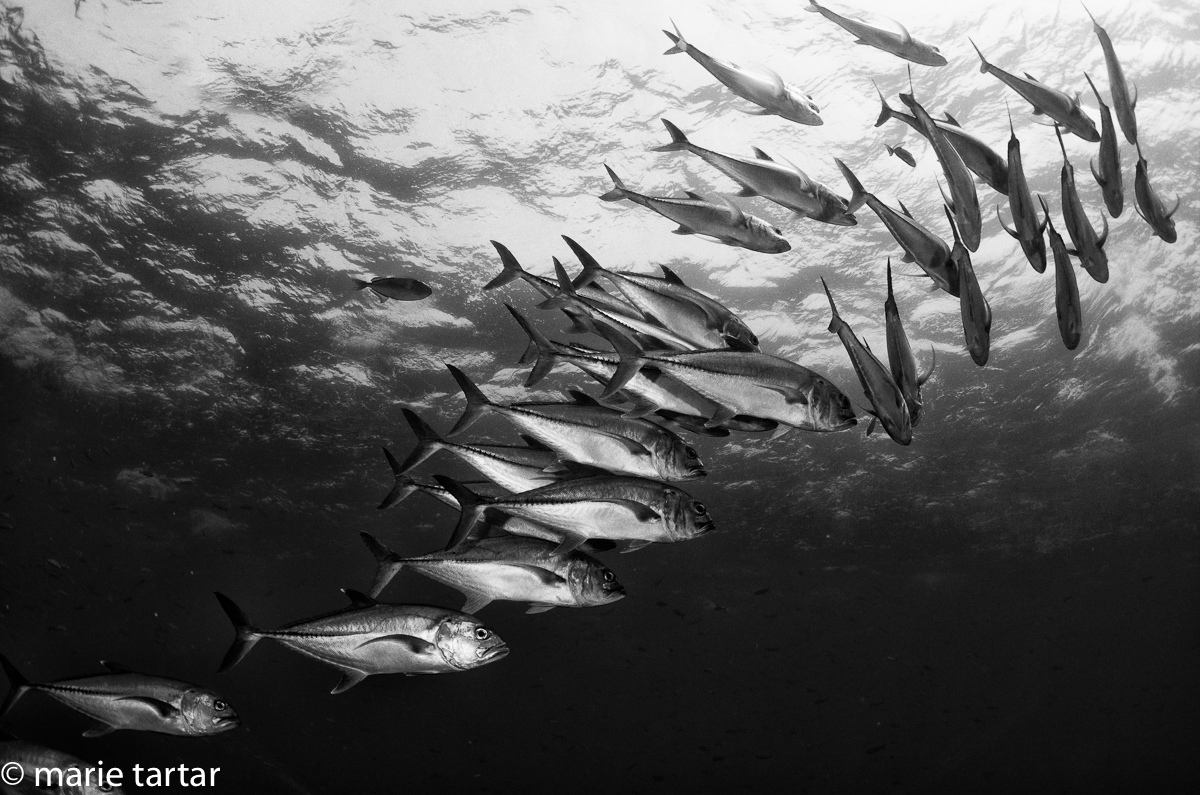
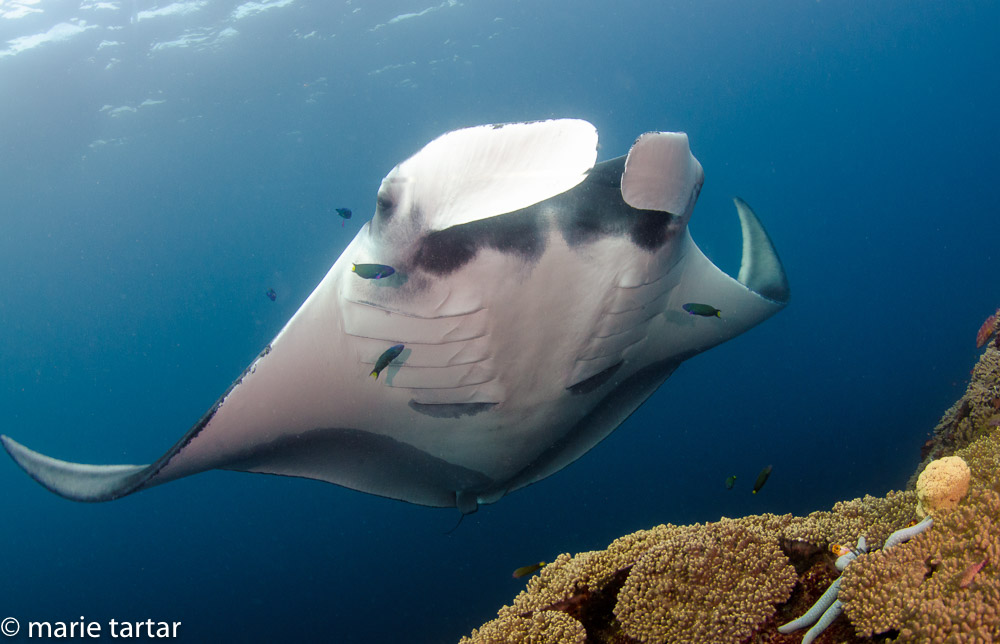


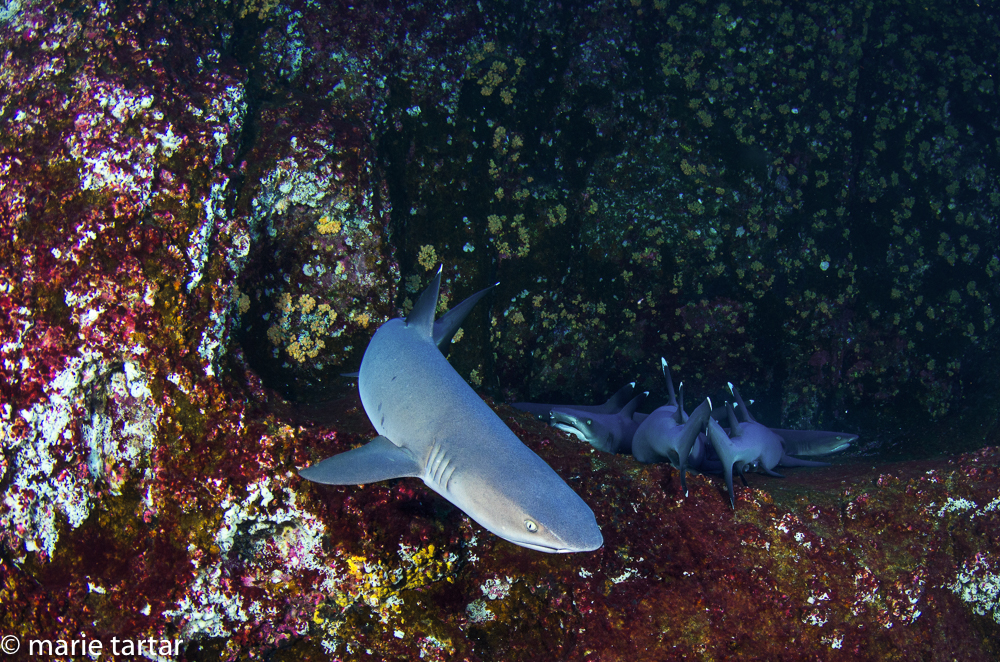


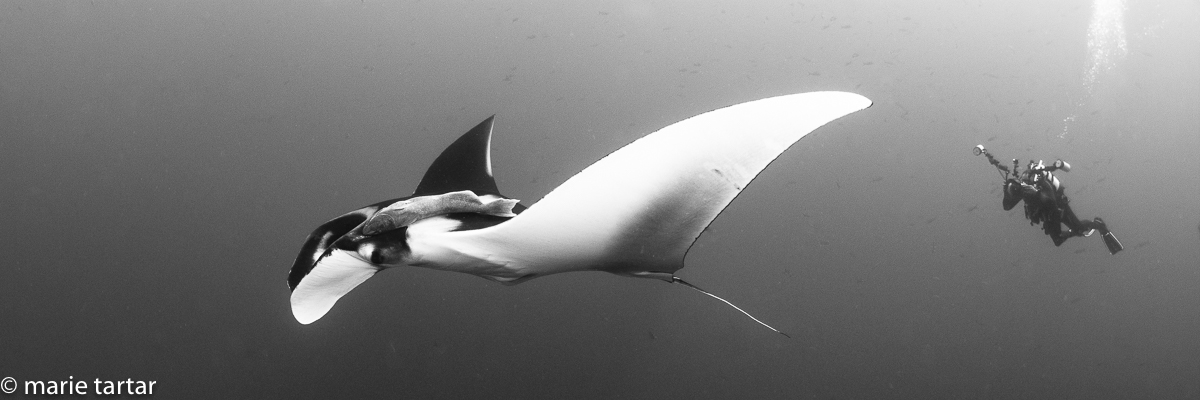
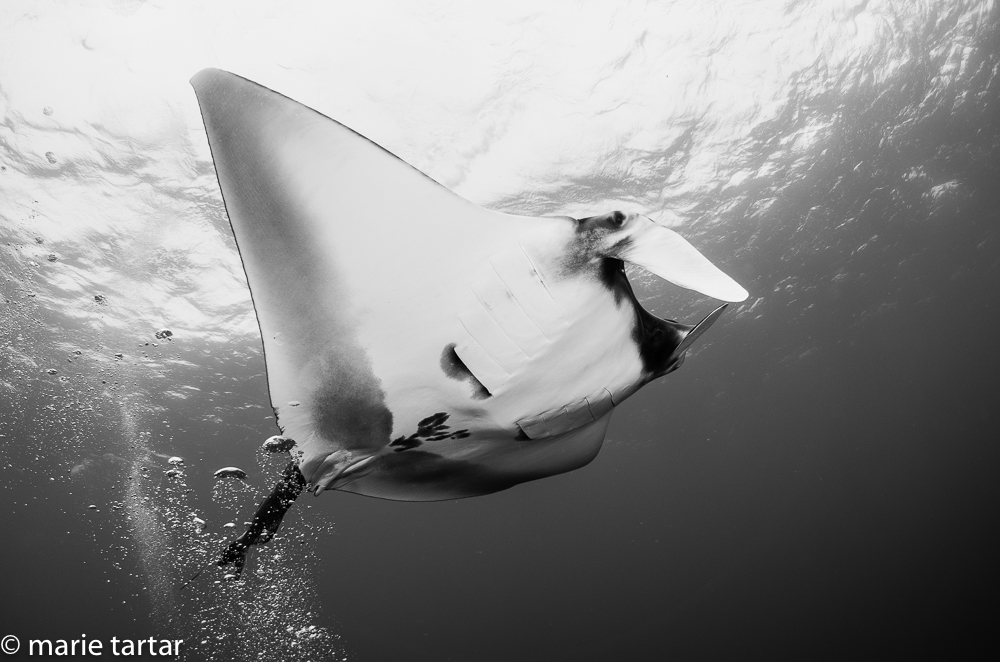

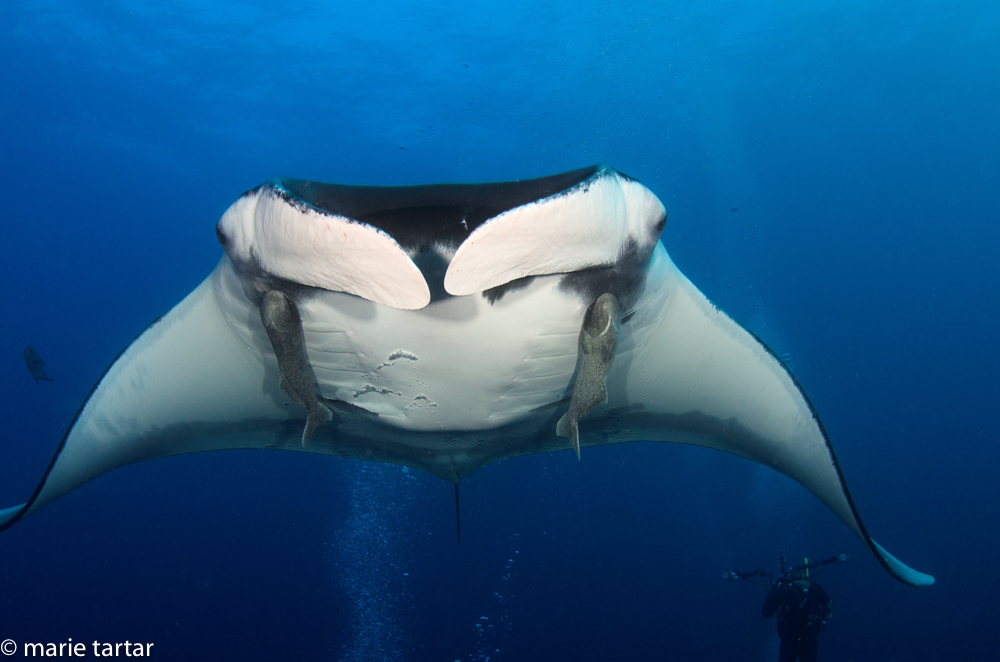
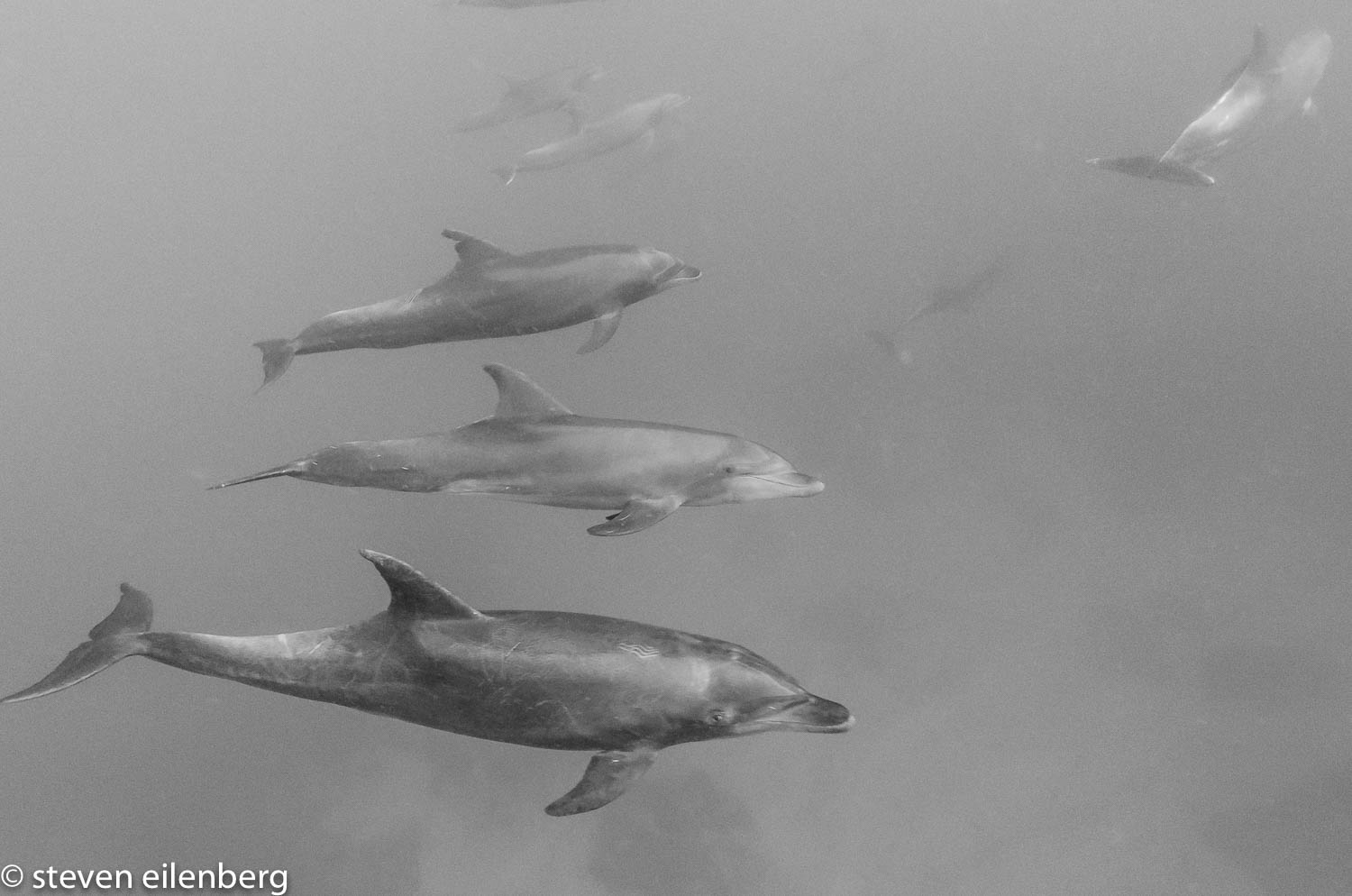
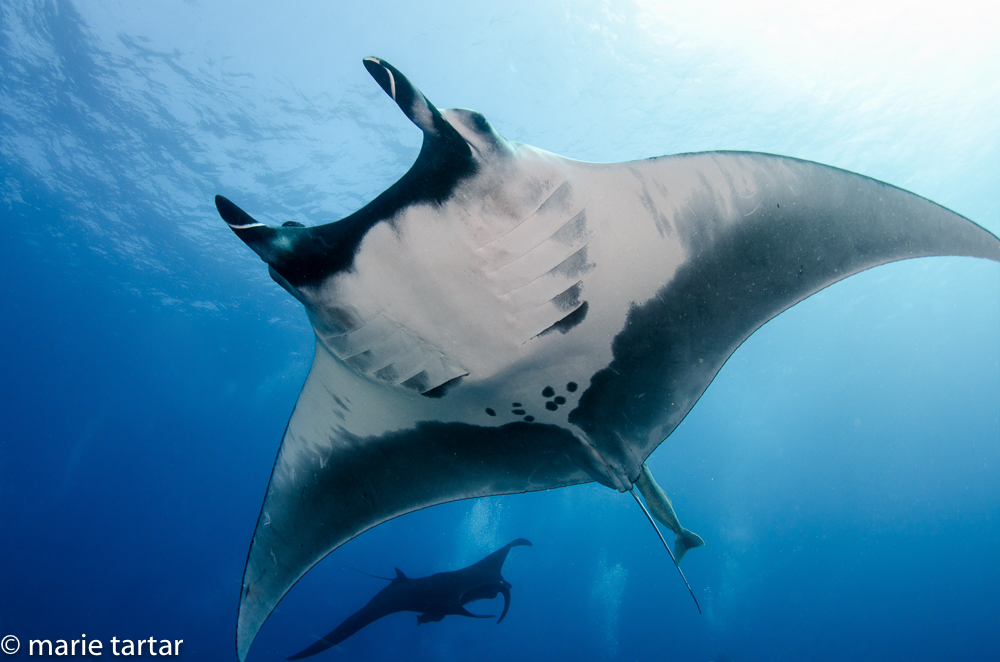
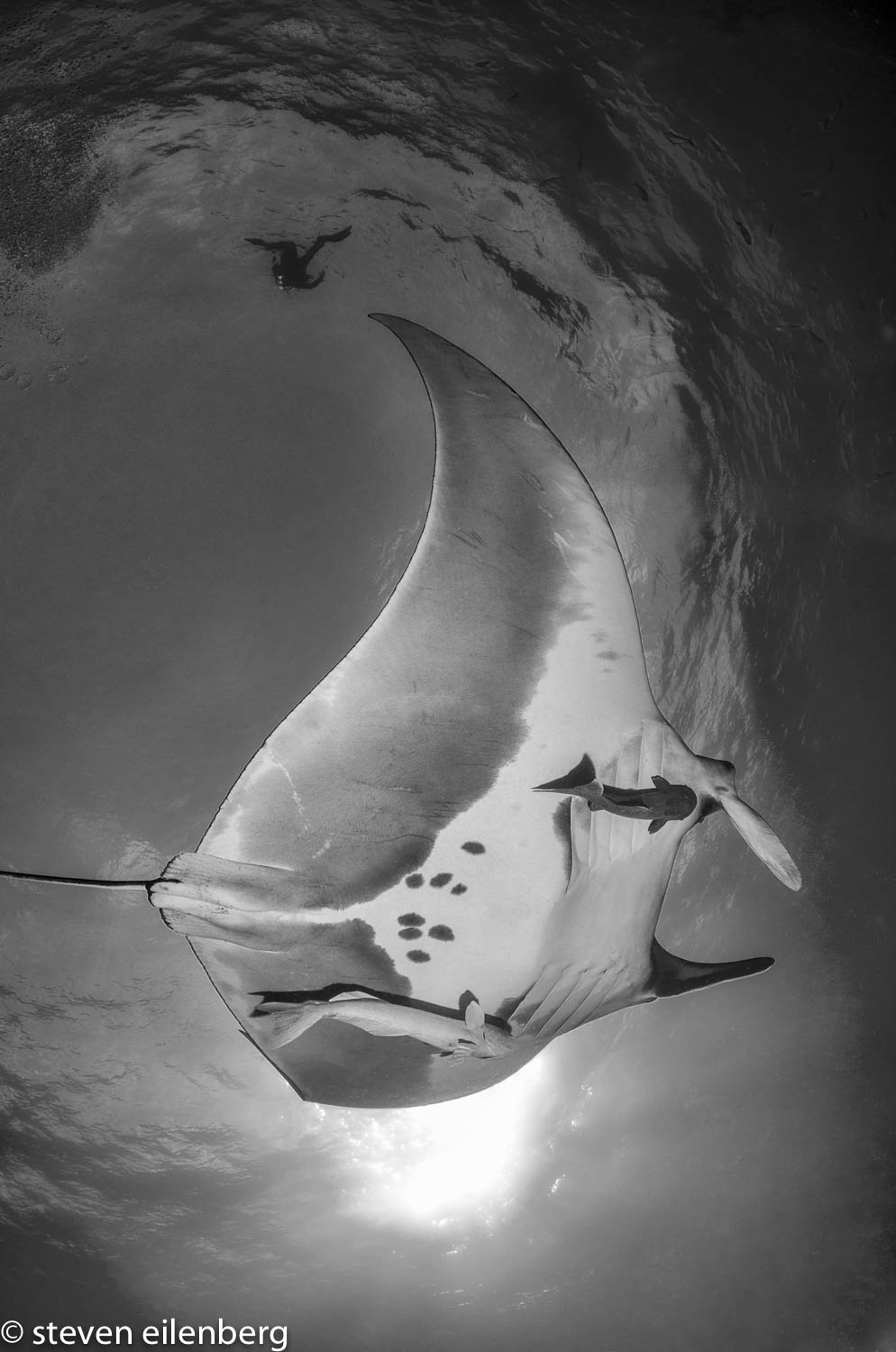
Great Trip! Looking forward to more adventures with everyone 🙂
Thanks so much for posting about another fantastic trip – complete magic!
Thanks for going on it with us, Heather!
I especially love the photos of the seabird following your boat and of the dolphins in the milky water. How odd it is that such uncomfortable and frustrating circumstances produced such lovely images.